Cat food aggression refers to when a cat gets territorial or possessive about its food and might lash out at other cats or even humans who come too close. It’s especially tricky if you have several cats, as they could end up fighting or hurting each other. And sometimes, food aggression can cause your furry friend to get feisty with people or other pets! So, it’s a good idea to tackle this issue as soon as you spot it.
There are many signs that your cat might be getting over-protective of her meals, but common signs of impending trouble include hissing or growling, eating quickly, blocking the food bowl with her body, and making low growling signs while eating.
That’s pretty shocking behavior to see if your kitty is generally a chilled-out character. So, what causes cat food aggression? Sometimes, if a kitten is weaned too soon, she might be very protective of her food source, certain medical conditions, past trauma, food deprivation, or a lack of training and socialization can all be to blame.
This guide helps you understand what causes your usually friendly furry friend to morph into a hissing, feisty feline at meal times and provides invaluable tips on correcting her behavior.
What Is Cat Food Aggression?
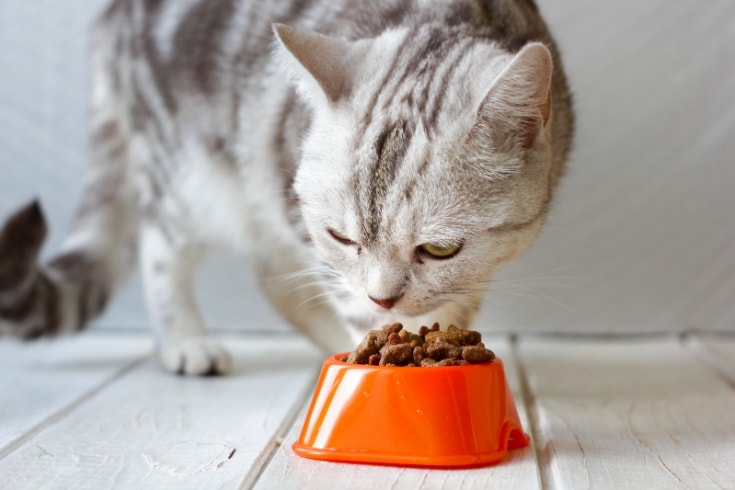
If you have more than one cat at home, you might encounter something called cat food aggression. That’s when a cat gets possessive of her food and might react aggressively toward other cats or even humans who try to approach while she’s eating. That can be quite challenging to manage, especially when you have multiple cats around, as squabbling over meals can sometimes escalate to all-out war!
Plus, cat food aggression can sometimes make your furry friend feisty towards other pets or people. That’s why it’s best to address this issue as soon as you spot a problem.
What Are The Signs Of Cat Food Aggression?
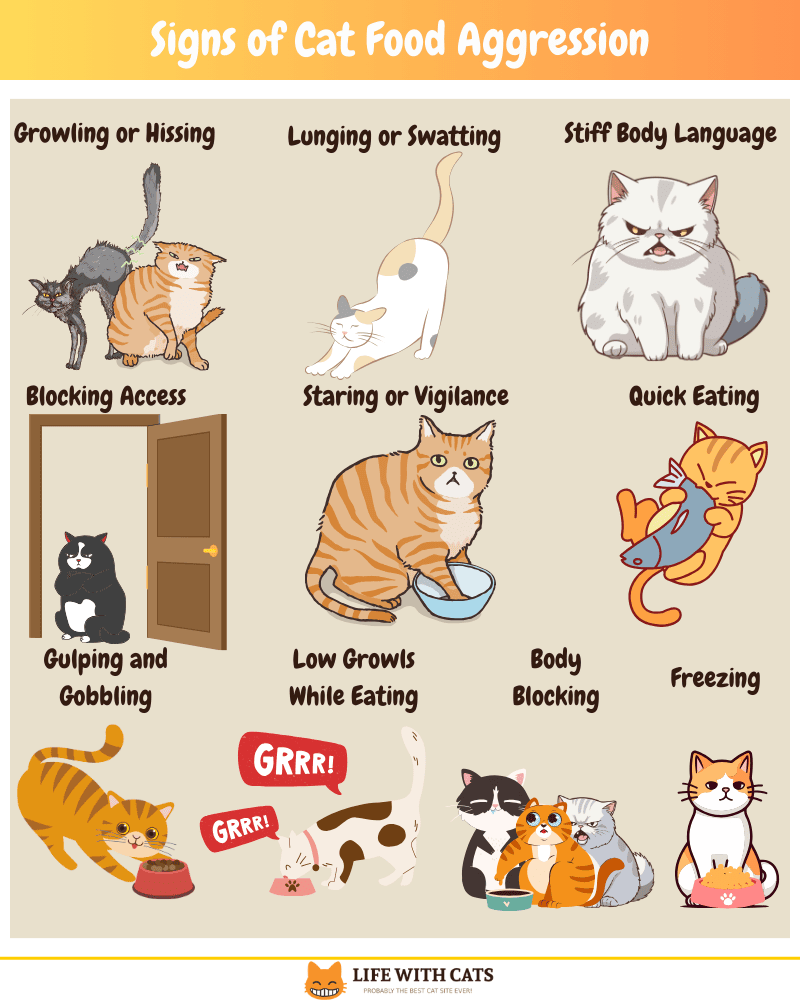
The signs of cat food aggression are alarming if your furry friend is usually chilled out and ready to cozy up for a cuddle. In seconds, your pet can undergo a total personality change and morph from a purring, head-bumping fluffball into a spitting, snarling, hellcat!
Keep reading to learn the signs of cat food aggression to watch out for!
Growling Or Hissing
If your cat starts growling or hissing when you or another cat approaches her food, that’s your cat’s way of saying, “Hey, back off!”
Stiff Body Language
If your kitty goes all statue-like at mealtime, she’s basically in high-alert mode, ready for any threats to her food source.
Lunging Or Swatting
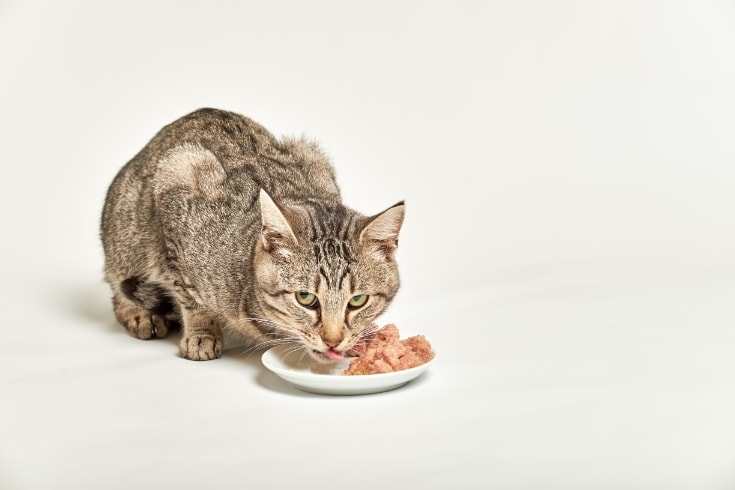
Lunging or swatting at one of her housemates is your cat taking things up a notch. Instead of just giving a warning, she’s now actively saying, “Seriously, back away from my dinner!”
Blocking Access
Sometimes, your cat might put her body in a position that prevents anyone from getting close to her meal. When cats block access to their food, it’s their way of saying, “This is mine, and I’m watching it.”
Quick Eating
We’ve all had those days when we eat super-fast because we’re starving and missed lunch. But if your cat always gulps down her food like she’s in a speed-eating contest, she might be worried someone’s out to snatch her meal away from her.
Staring Or Vigilance
If your cat’s eyes are darting everywhere while they eat or she sits in front of her food bowl staring at you, she’s most likely playing lookout, as if she’s expecting someone to make a sneaky move on her meal.
Freezing
A cat that suddenly freezes while eating is responding to a perceived immediate threat. Pausing allows the cat to check out the situation and decide whether to run away, carry on eating, or get defensive.
Gulping And Gobbling
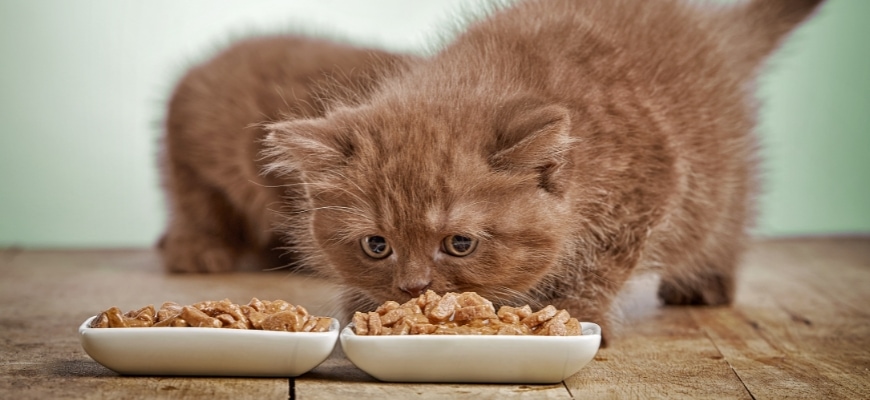
It’s one thing to be a fast eater, but if your cat’s acting like every meal is her last, gobbling everything up, she most likely feels a bit protective of her grub.
Body Blocking
This behavior is like the cat version of a bodyguard at a celebrity event. Instead of just using its posture to shield the food, the cat uses its whole body to guard its precious meal. It’s like saying “No one touches my food!” and then some!
Low Growls While Eating
When your cat makes a low growling sound while she’s eating, that’s the feline equivalent of mumbling under her breath, “I’m watching you…” She’s just making it known she wants to eat in peace and will get defensive if she has to.
What Causes Food Aggression In Cats?
The causes of food aggression in cats are unique to every cat. So, if your furball is showing some food-guarding vibes, understanding the cause is the first step to helping them chill out a bit at mealtimes. If you can pinpoint the trigger for this distressing behavior, you’re halfway to finding a solution.
So, here are the most common causes of food aggression in cats.
Premature Weaning And Deprivation
Kittens are usually old enough to be weaned once they can stand up, play, and focus their eyes, typically at around four weeks old. Cats that were weaned too early or didn’t get enough food as kittens can become super protective of their meals.
The same is true of cats abandoned at a very young age.
Stress
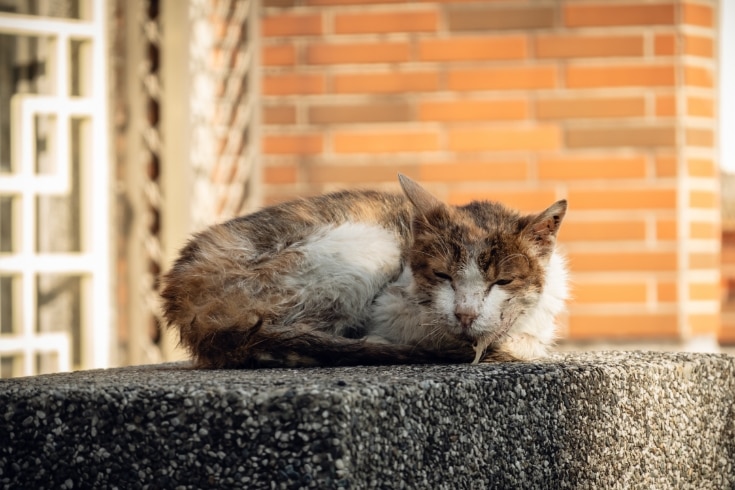
Stress causes all kinds of behavioral quirks in cats, including food aggression. Unfortunately, stress can be triggered by lots of different things, including the introduction of a new pet, physical discomfort, lack of environmental stimulation, or changes to the cat’s environment, such as a house move.
Although it’s not something I’ve experienced, cats adopted from shelters or rescues can sometimes be prone to displaying food aggression behavior, especially if they have spent years on the streets.
Multi-Cat Families And Homes
Living with lots of cats around can be like having a big, bustling family dinner every night. Some cats might feel the need to “secure their plate” from their housemates by exhibiting aggressive, protective behavior at meal times.
In addition, a cat in a multi-pet household won’t be able to eat privately, which can cause resource competition, and that’s often made worse when the cats are fed large meals once or twice daily.
Hunting Vs. Meal Feeding
Wild cats hunt for their food, protecting their kills from all-comers. Although domestic cats get meals easily at home, many still have their instinctive hunting mentality when it comes to defending their food source from all-comers.
According to one theory, cats have evolved to graze, eating whenever food becomes available during the day, which could mean feeding anywhere from nine to 16 times! So, feeding your cat one or two large meals daily can frustrate your cat’s natural Instinct, potentially leading to displaced aggression.
Also, a cat’s digestive system is designed to handle multiple small meals throughout the day rather than two or three big feeds within a 24-hour period. As well as breakfast and dinner, my cats tend to pop in and out for a snack at intervals throughout the day, so I guess their feeding regimen is pretty much in line with wild cats’ natural behavior.
Positive Reinforcement
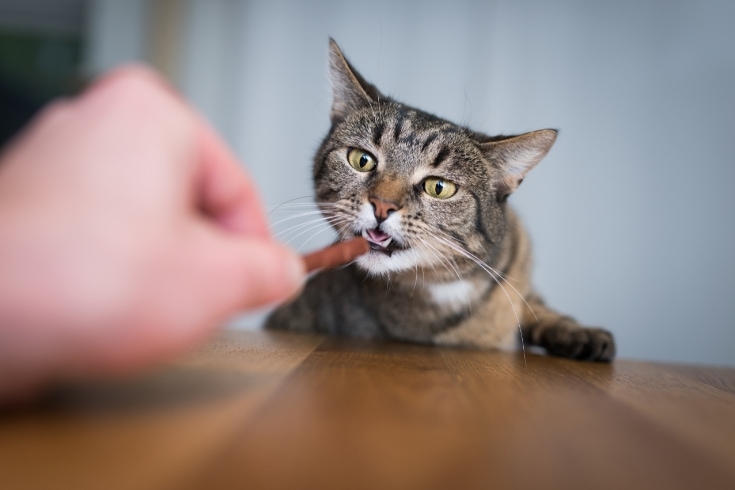
Although positive reinforcement is a good thing when used to train a cat, a cat that acts possessively around her food without reprimand gets to think that her behavior is acceptable. So, by not modifying your cat’s food-guarding behavior, you’re telling her that’s okay.
Health Problems
If your kitty’s not feeling well or has an underlying medical issue, she can act out around food. That’s typically because your cat feels weakened and vulnerable, so she’s protecting her food source as best she can.
For example, some health conditions such as hyperthyroidism, which is quite common in senior cats, cause the body’s metabolism to increase, leaving your pet feeling hungry constantly. Periodontal disease causes pain and that can make your cat irritable and more likely to be aggressive while she’s eating.
PAFB – Psychogenic Abnormal Feeding Behavior
PAFB or Psychogenic Abnormal Feeding Behavior could be caused by some kind of stress-related underlying psychogenic or mental problem, although what causes the condition has not been fully established.
Instinctual Behavior
Cats have evolved an instinct that tells them to protect what is theirs, including their valuable food resource, and that can trigger aggression at feeding times.
Early Socialization And Learning
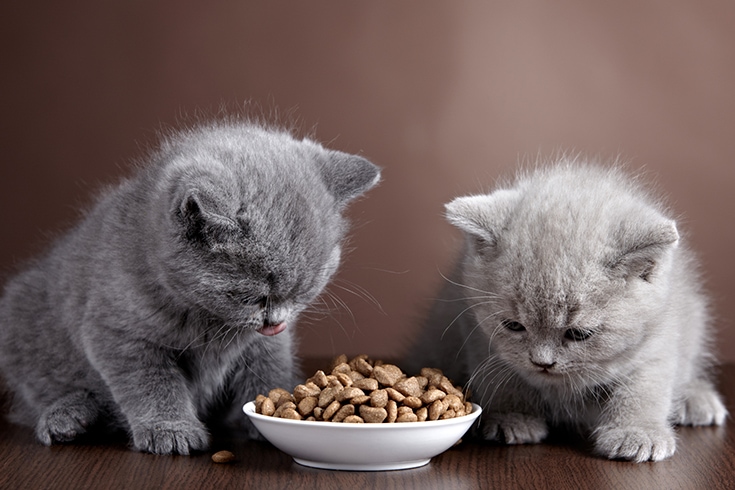
Kittens learn a lot about life when they’re very young, and if a kitten learns that food is a scarce resource or needs guarding, they’ll carry that lesson into adulthood.
Past Trauma
Just like humans, a bad experience in the past can affect how cats behave now, especially around food. For example, if a cat has lived on the streets and been chased dumpster diving for scraps, she will most likely become very defensive and aggressive around her meals even though she now lives comfortably with plenty of food available.
Negative Associations
In a similar way to past trauma, if something bad or scary happened to the cat one time while she was eating, she might associate food with that event and get aggressive as a form of defense.
Medical Issues
As with health issues, if your feline friend is not feeling well or is in pain due to an underlying medical issue, she can act out around food. That’s usually because your cat feels weak and vulnerable, so she’s protecting a valuable source of nutrition.
Inconsistent Feeding Routine
We all love routine, right? Your cat thrives on it, and if her feeding times are all over the place, it can make her anxious. That often leads to aggression or food guarding since your furry friend can’t be sure when or if her next meal will arrive that day.
Lack Of Socialization
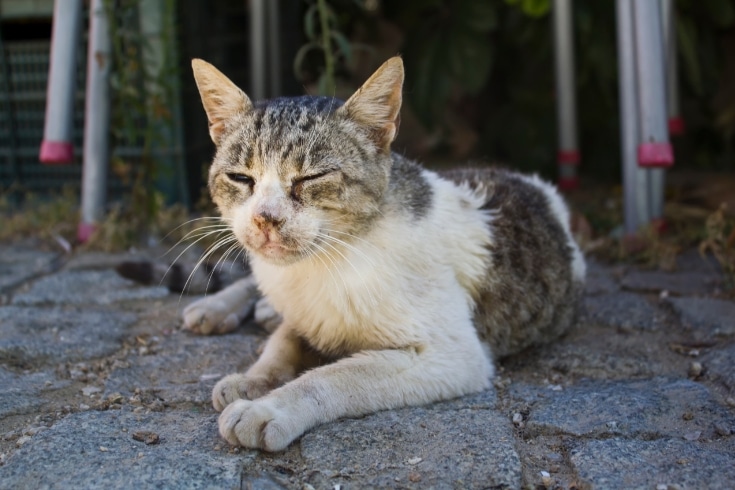
Cats not used to being around others, such as former strays or feral cats, might get nervous or possessive when someone comes near their grub.
Prior Negative Human Interaction
If someone’s been mean to your cat or teased her during mealtime, your pet might be wary whenever a human’s around as she eats. That can be the case in a home with young kids or other pets, so if that sounds like your home, be sure to supervise your cat at mealtimes or feed her in a place where she won’t be disturbed.
I had problems with my puppy pestering the cats at feeding times, so I started feeding my kitties in a room with the door closed but the window left open so they could get out once they’d finished their meal. That way, the cats are left in peace to eat and the greedy pup can’t finish up any leftovers!
High-Value Food
Some cats get very protective and aggressive over high-value food and treats. Much like your favorite snack, some foods are just so tasty, that your cat can’t help but guard it!
Fear Or Anxiety
If your cat is frightened or anxious, she might act aggressively around food and try to bolt her meals as quickly as possible. Check that nothing in your home could be stressing your cat or making her afraid, and take steps to ensure a peaceful, secure environment for her where she feels safe and relaxed.
Lack Of Training Or Socialization
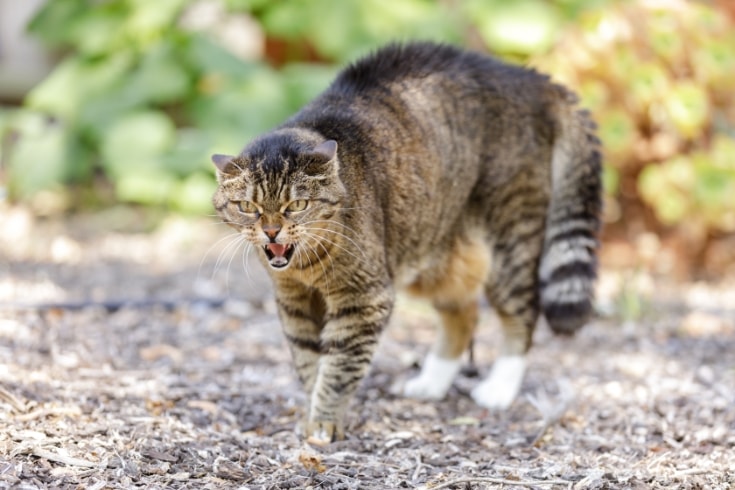
Cats unfamiliar with the company of others, like former strays or feral cats, can become anxious or protective when a stranger approaches their food. The same can be said of cats that haven’t been trained in basic obedience and simple commands.
How Do You Manage Cat Food Aggression?
To manage food aggression in cats, there are several steps you can take. However, Before you take any of these measures, we recommend having your cat checked over by a vet to be sure no underlying health issues are to blame.
If your cat gets a clean bill of health from the vet, here are a few things you can try to moderate and manage her behavior at mealtimes.
Don’t Tolerate Begging At The Table
If you have a furry feline companion around you while you’re eating, it’s possible that she’ll feel hungry too. However, it’s not a good idea to give your pet table scraps as that could lead to her constantly begging for food.
For undisturbed mealtimes, it might be better to keep your cat in another room so you can enjoy your dinner in peace.
Instead Of Food, Lavish Your Cat With Attention
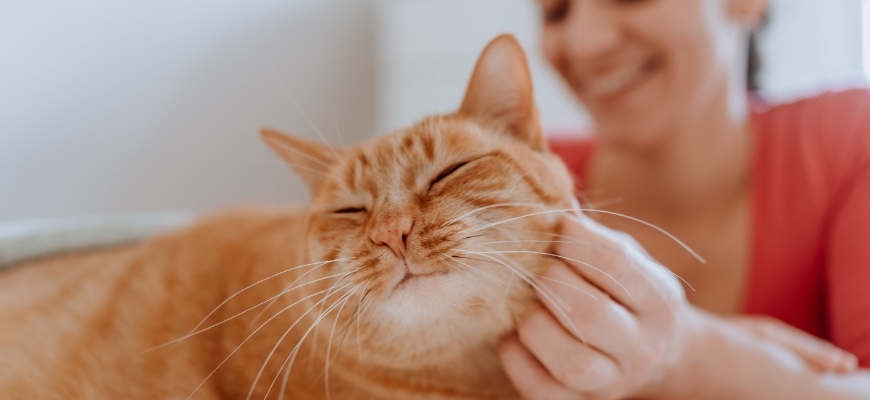
It’s all too easy to give in and feed your cat whenever she bugs you for treats! It might seem like you’re in charge, but your cat is actually pulling the strings and “training” you! Giving your cat what she wants is an easy way to get her off your back for a bit, but it just makes your pet think she can get food whenever she wants.
Instead, try playing with your feline friend more and spending lots of quality time together. That’s a much healthier way to keep your kitty happy and active than stuffing her with snacks!
Reinforce Desired Behavior And Ignore The Bad
If your cat constantly begs for food and you yell at her to stop, that’s a form of reinforcement, simply because your cat is getting your attention. By consistently ignoring undesirable behavior and being quick to reward good behavior you can retrain your cat.
For example, when your feline friend is calm and quiet when she is by her food bowl, shower her with praise so she knows you’re pleased with that behavior.
If Your Cat Growls While Eating, Give Her Space During Mealtime
If your cat growls while she’s eating, give her some space and be sure to feed her alone in a quiet spot. Using food puzzles or modifying your pet’s diet can also help your cat to eat more calmly. Remember, mealtimes should be stress-free and enjoyable for your furry friend!
Feed Your Pets Separately
In a multi-pet household, feeding each cat in a different room usually reduces stress at meal times. Forcing cats to share the space can encourage resource guarding and competition, and increase aggressive behavior. If you prefer to allow your cat to graze (ad libitum feeding), putting feeders around the house can stop guarding behaviors and aggression around the food. bowl.
Give Smaller Meals, Multiple Times A Day
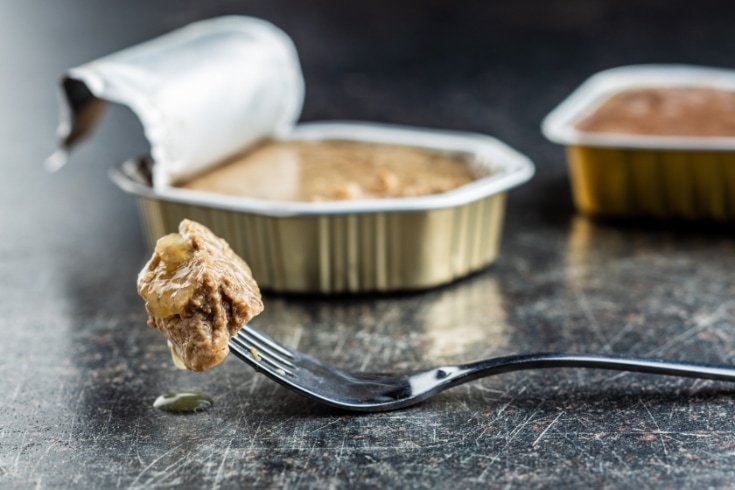
To replicate the natural hunting behavior of cats, try splitting your pet’s daily ration into five or more portions and feed her regularly throughout the day.
Food Puzzles
Using food puzzles to feed your cat some of her daily food allocation can be a great way of providing your pet with mental and physical stimulation. Food dispensing toys encourage natural scavenging and hunting behaviors as well as allowing your cat to eat many small meals during the day at different places around your home.
Diet Modification
When you’re shopping for cat food, always think of quality over quantity. Although cheaper, generic brands might save you some cash, they’re often packed with fillers and weird additives. But with the premium options, you can rest easy knowing your feline friend’s getting all the right nutrients for her age and health.
Dietary Supplementation
Some studies on dietary supplementation show that some supplements can reduce aggression and anxiety in cats. Ask your vet for more advice and information on whether a dietary supplement could help reduce or modify your cat’s food aggression.
Minimize Stressors
Think about what things could be stressing your cat in her immediate environment and take steps to remove or manage them. If your cat lives in a peaceful, secure home where she feels safe and relaxed, food aggression is less likely to be a problem.
How Do You Stop Food Aggression In Cats?
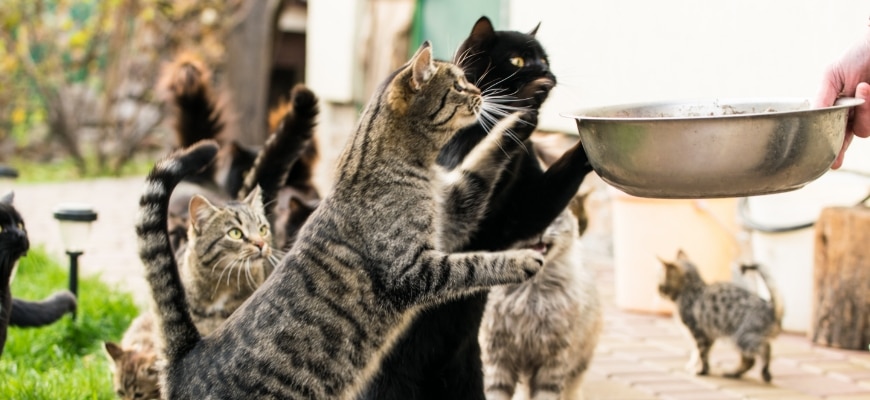
To stop food aggression in cats you must first identify the cause of the behavior. Once you’ve worked out what’s triggering your feline’s feisty attitude around her grub, you can take steps to stop it.
Here are some tips on how to stop food aggression in cats before things get out of hand.
Identify The Aggression
First, you need to identify what’s making your cat so tricky around her food bowl. As outlined above, your cat’s sudden food aggression could be caused by competition in a multi-cat household, past traumas, or underlying medical issues that might be causing pain or discomfort while your pet is eating.
Consult A Veterinarian
Bearing that in mind, your first port of call is your veterinarian. Your vet should be able to identify any physical problems and treat them, which could fix your furry friend’s food-guarding issues.
Create A Calm Environment
Stress can be a major cause of food aggression, especially if you’ve recently moved home and upset your cat’s routine. Try to create a calm environment to relieve stress and help your cat relax.
Consistent Feeding Routine
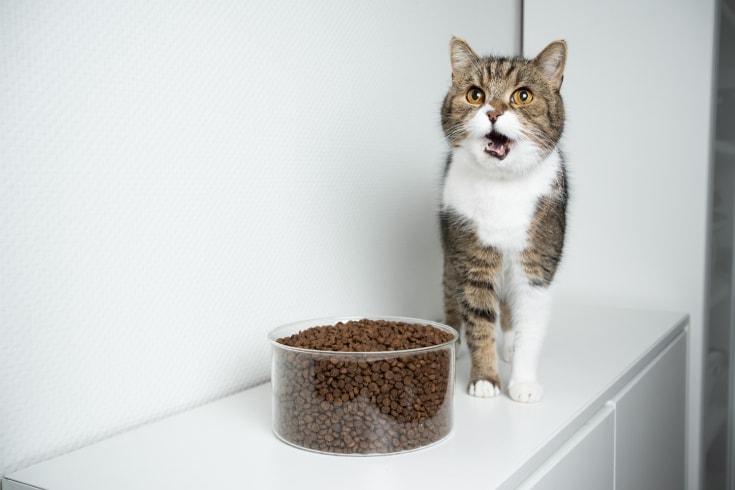
Cats are creatures of routine and they like to know what’s happening throughout their day, especially when their meals will be served! If you don’t have a regular feeding routine for your kitty, she won’t know when and if she can expect food, which can make her feel insecure, potentially triggering aggressive behavior at mealtimes.
Separate Cats
In a multi-cat home, one cat might be larger, greedier, and more assertive than the other, which can lead to bullying. The easy fix for that problem is to feed the cats in different rooms.
Use Multiple Feeding Stations
To remove the focus from one feeding station, try setting up several feeding stations around your home. That way, if one cat wants privacy to eat, she can chow down away from her housemates, your kids, and even her doting owner!
Positive Associations
Sometimes, if your cat associates feeding times with a past trauma or other unpleasant experience, you will need to think outside the box and change those negative associations to positive ones.
Try using positive reinforcement techniques, including reward and praise when your cat remains calm around her food bowl.
Slowly Introduce Changes
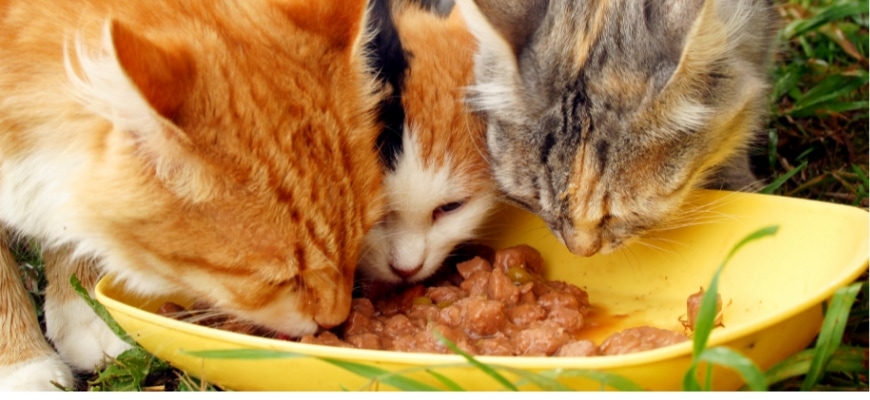
As mentioned above, cats are very much creatures of routine, and any changes to their environment can wreak havoc at mealtimes. So, if you change things around in your home, always do so gradually to give your cat a chance to process what’s happening.
Desensitization
If your cat has food aggression, desensitization can help. Basically, you want to slowly introduce your cat to the thing that triggers their aggression, but in a less intense way. Start by putting their food down from a distance and then slowly move closer as your cat becomes more comfortable. Just make sure that your cat stays calm throughout each step!
Practice Training
Training your cat to wait for her food can prevent aggression. Teach your cat simple commands, such as “stay” or “wait,” and over time, your pet will learn that only by staying calm she will get a yummy dish of food.
Food Puzzle Toys
These toys are pretty cool because they only dispense food when your cat plays with them. Plus, food puzzles can help occupy your cat’s mind and distract her from getting aggressive at feeding times. And here’s the kicker: using these toys can actually teach your cat that food doesn’t always come from you, which can help reduce any aggression she might have towards you!
Positive Reinforcement
Make sure to give your cat some love when she’s being good, especially around mealtime. Use positive reinforcement and give your pet treats, kind words, or a good petting session to reward her when she keeps calm. Eventually, your furry friend will learn that being well-behaved and chilled out is a good thing!
Avoid Punishment
Punishing your cat for getting aggressive around her food will only make the problem worse. instead of understanding why she’s being punished, your pet might begin to associate that negative experience with meals, possibly triggering even worse behavior.
Professional Help
If you’re struggling to manage your cat’s food aggression on your own, you might want to consider asking a professional for help. A vet can rule out any medical issues, while an animal behaviorist can help you address your cat’s behavior through training and other tactics.
FAQs
In this part of our guide, we answer many of the most frequently asked questions about food aggression in cats.
Why Is My Cat Suddenly Aggressive Over Food?
It’s not uncommon for cats to get aggressive over food, but it’s worrying for you and can be disruptive and downright dangerous in a multi-cat home, especially if you have little kids around. There are a few reasons why your cat is acting that way.
Firstly, your cat could feel threatened, stressed, or anxious. If your cat feels like she has to compete for food or is worried her food source will be taken away, she could get defensive or aggressive, especially in a multi-pet home.
Another reason could be a medical issue. If your cat is in pain or discomfort while eating, she might lash out. So, it’s important to schedule a vet visit to rule out any underlying medical issues, especially if the aggression suddenly appears from out of nowhere.
Finally, it could simply be a matter of your cat’s personality. Some felines are just more possessive over their food than others. In that case, you can try feeding your cat in a separate room or using a puzzle feeder to slow down her eating and make mealtime more enjoyable.
Can Neutering Or Spaying Reduce Food-Related Aggression?
Although some behavioral problems can be resolved by neutering or spaying your cat, food aggression is not necessarily one of them. That said, if your pet’s aggression around food is linked to territorial behavior, having her desexed could help, but you should ask your vet for advice on that.
Is It Possible To Train An Older Cat Out Of Food Aggression?
Yes, it is possible to train an older cat out of food aggression using the methods outlined earlier in this article. However, older cats can be somewhat set in their ways, so you will need to be patient and consistent in your approach to training your senior feline.
How Can I Feed Multiple Cats Without Triggering Aggression?
The easiest way to feed multiple cats without triggering aggression is by placing several food bowls around your home to give the cats options. Also, you can try feeding the cats in separate rooms, depending on how many you are catering to and how large your home is!
What Role Does Dominance Play In Cat Food Aggression?
Dominance can play a part in cat food aggression. Simply put, some kitties might try to assert themselves as the “top cat” by hogging the food dish or swiping at their housemates during mealtime. It’s your cat’s way of saying, “This is mine, back off!” But remember, cats have personalities, too, so not all food-related tiffs are about dominance; sometimes, it’s just about that tasty tuna!
Conclusion
Food aggression is the term used to describe when your cat gets feisty at feeding times. That can be distressing for everyone in your home, and if you get too close, you might even get scratched or bitten, so you must take steps to fix the problem sooner rather than later!
Food aggression can be caused by competition in a multi-cat household, underlying medication issues, previous trauma, and your cat’s personality.
You can prevent and manage food aggression in your cat by using food puzzle toys, feeding multiple cats in separate rooms, and training your pet to wait patiently for her food. If all else fails, consult a vet or animal behaviorist who can help you manage your furry friend’s food aggression issues.